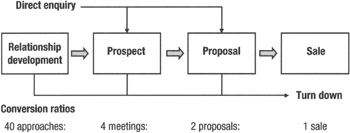MONITORING SALES PERFORMANCE
Monitoring sales performance is important for two reasons: 1) it shows what the level of future sales is likely to be, and where sales effort needs to be directed; 2) successful sales performance can be analysed to identify what were the reasons for success and hence provide a guide to good practice.
For the purposes of monitoring sales performance a client can be allocated to stages in the selling process as follows:
-
Sales development. When sales activities are aimed at developing a relationship with the client, but when there is no specific project in view.
-
Prospect. Where there is a specific project (or projects) in view, but for which the practice has not yet received a request for a proposal or invitation to tender from the client.
-
Proposal. A proposal has been submitted to the client that the practice should carry out a specific project.
-
Sale. When the client has accepted a proposal and it is now in the order book.
The whole process can be thought of as a leaky pipeline (see Figure 4.6); at each stage, prospective clients will drop out until only a few are left that lead to sales. As well as clients arising from sales development, prospects and proposals may derive from direct enquiries. There will also be clients lost at each stage (called turn downs) because of, for example, the deferral or cancellation of a project, or a contract that is awarded to a competing provider of consultancy services. Figure 4.6 shows the ratios that were calculated by one consultancy salesperson.

Figure 4.6: The sales pipeline
Clearly the ratios will vary with time, product, market and salespeople. On the figures shown, on an average of the 40 prospects the salesperson started with, only one resulted in a sale. The significance of this is that if you are to be a successful hunter you have to start with a large number of organizations that you believe could be clients for your service. You have to accept a lot of 'Nos' with only a few 'Yes's'. Sales performance will be measured by the volume of business (number of clients, value of projects, etc) at each stage in the sales process; the conversion of business from one stage to the next.
To this end, sales activity needs to be monitored, and examples of the type of information that can be recorded are shown in Figures 4.7–4.9. These show the information on forms, but it is more normal to keep the data on a computer database. These should be updated regularly. The layout of the records means that the status of the sales process to a client can be quickly assessed, and action taken to follow up where required.
Sales Development Record
Sales development is the development of a relationship with a potential client, targeted as being a likely buyer of your services. It should be the responsibility of a salesperson assigned to that target. A sales development record is shown in Figure 4.7.
| Account manager | Client | Current position | Next action | By when |
|---|---|---|---|---|
Figure 4.7: Relationship development record
It takes some time to develop clients in this category into prospects, and it is easy to let this category get too small. You should therefore review on a regular basis whether the level of activity in this category is sufficient.
Prospects Record
Prospects can arise from either potential clients already identified in the sales development process or direct enquiries. New prospective projects with clients for whom you are currently working should be included here.
| Account manager | Client | Possible project | Likely revenue | Probability | Current position | Next action | By when |
|---|---|---|---|---|---|---|---|
Figure 4.8: Prospects record
Proposals Record
| Account manager | Client | Project | Value | Probability | Current position, competition etc | Next action | By when |
|---|---|---|---|---|---|---|---|
Figure 4.9: Proposals record
Other Uses
It is important to monitor the conversion rate from one stage to the next. Key ratios to monitor are: number of sales divided by number of proposals; and value of sales divided by value of proposals. Typically in management consultancy these figures might be one-third to a half - that is, only one in two or three proposals is accepted. If the ratio becomes too low, this can be a sign that either you are bidding for the wrong business, or that your proposals are insufficiently competitive. Likewise, a high conversion rate might indicate opportunities for business expansion. Reasons for proposals being turned down should be monitored through win-lose reviews with the client so that conversion performance can be improved.
Of course, the records need to be kept up to date. This means being honest about those prospects that show no sign of turning into business. It is a matter of judgement which clients should remain on the Sales development and Prospects records. You may wish to remove a prospective client from the sales records if the likelihood of any revenue deriving from the effort is low.
Finally, use these sales records as a basis for improvement. Review performance to find out what techniques are successful, and which clients are the best bets. Distinguish successful performance from unsuccessful, and so build up an understanding of what constitutes good selling practice for your consultancy firm.
EAN: 2147483647
Pages: 89